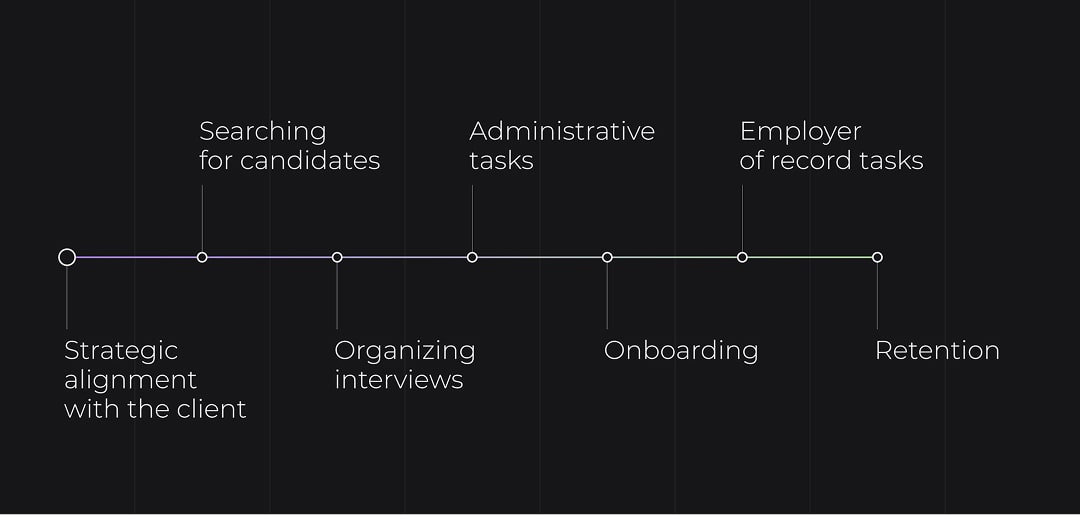In the era of hunting for the best tech professionals in the market and retaining them long term, businesses are in dire need of an HR partner. Human Resources, also known as HR Operations, or HR Ops, helps companies follow their strategy and make businesses more effective by managing and engaging top specialists.
Playing an intermediary role in the relations between business and professionals, HR serves a company’s mission, but meets the needs of the new hires and already retained specialists who transform even the most audacious business ideas into reality. The global HR technology market was valued at $38.99 billion in 2025 and is projected to reach $57.98 billion by 2030, growing at a CAGR of 8.20% during 2025–2030. This tendency clearly shows the need companies have for HR Operations roles and responsibilities, as well as their functions.
HR Operations’ Functions and Duties
Human Resources Operations is often mistakenly associated with the supporting department for the business’ needs. However, it plays a far more strategic role, contributing directly to a company’s growth and edge in the market. By shaping the core team, HR Operations builds scalable systems, ensures cross-border compliance, and creates the conditions for talent to thrive.

Here are a number of core responsibilities of HR Operations, which are not exhaustive and can deviate from business to business.
Talent Acquisition and Recruitment
The journey to find the most experienced developers in the market starts with understanding the business strategy. Only after the analysis of a company’s goals is done, HR Operations moves to tech recruitment and staffing services. The main steps include finding suitable candidates, initiating background checks, screening candidate’s resumes, setting up interviews, and managing the recruiting process.
Today, many of these steps are supported by automation and AI tools — resume screening software, automated interview scheduling, and programmatic job ads help reduce time-to-hire and improve candidate matching.
Depending on the urgency of filling in the position and the qualification of a potential candidate, recruitment can change its duration and the number of steps. For example, while some companies prefer to scrutinize the candidates’ technical skills and prolong the interview to five and more steps (which is not always a good idea), others confine to one to three interviews. That’s why it is especially important to have clear communication and cooperation between Human Resources and the business.
If a company prefers moving HR functions from internal processes to outstaffing model, this stage remains more or less similar. However, by leveraging external HR partners, small and mid-sized businesses can benefit from cost-efficient hiring, access to niche tech talent, and reduced overhead. This function also highlights one of the core HR operations roles: building scalable, agile talent pipelines that align with evolving business needs.
Whether you’re looking for a 2025 hiring strategy for small companies or searching for a remote talent sourcing partner, HR Operations must combine strategic alignment with the latest recruitment technologies to stay competitive.
Struggling to find the right tech specialists fast? With Outstaff Your Team, you get access to pre-vetted talent pipelines, streamlined hiring processes, and full recruitment support aligned with your business goals.
Hire smarter with us
Training and Onboarding
This function receives more and more focus recently. Some companies still omit onboarding services, concentrating rather on talent hunting and acquisition. But the data show that this is one of the key factors in talents retention, as the companies with well established onboarding manage to retain 58% of their team members in the next three years. Good onboarding programs help new hires integrate quicker into a company’s working process and even perform better during their first milestones.
Training and onboarding not only include legal paperwork, such as signing contracts or filling in personal details. Their key role is to introduce new specialists to the business, their new roles and a company’s expectations. HR functions include preparing the working environment for a new hire so that they feel motivated, involved, and appreciated.
For fast-moving teams, onboarding means the make-or-break moment that determines whether a new hire will settle in or start browsing LinkedIn two weeks later. We’ve seen that when companies pair each newcomer with a mentor, walk them through role-specific expectations, and use collaborative tools to guide their first 30 days, the results are tangible. They see higher engagement, faster performance milestones, and fewer early exits.
From our experience, HR operations responsibilities now include designing onboarding flows that feel personal, not generic. That means legal compliance, yes, but also making sure people aren’t left guessing about what success looks like in their role.
Compensation and Benefits
One of the key roles and responsibilities of HR operations is managing fair, timely, and compliant compensation. Beyond handling payroll, HR teams now rely on various tools to benchmark salaries, monitor equity distribution, and build competitive packages that attract top talent, especially in remote and hybrid environments.
Benefits, too, have evolved. Mental health stipends, flexible work allowances, and 4-day workweek pilots are no longer perks, they're expectations. Modern HR uses real-time engagement data and feedback tools to adjust offerings before retention issues arise.
For SMBs, outsourcing compensation and benefits admin reduces risk and overhead. That’s why many companies are looking for a compensation strategy for remote teams to stay competitive without overloading internal resources.
Managing payroll, benefits, and compliance across markets doesn’t have to be overwhelming. Outstaff Your Team handles the HR operations backbone, so you can focus on growing your business, not the admin.
Talk to our specialists
Legal Compliance and Safety
Whether a company’s operations are limited by one country or multiple legal entities, Human Resources Operations always ensures the work follows all legal requirements. Keeping records and documentations is not its only duty. HR helps with all checks regarding local and international laws. If the hiring is done overseas, HR ensures talent follow regional working hours and public holidays, handle employee disputes, and manage workplace relations.
HR often undertakes Employer of Record (EOR) and manages data protection standards like GDPR and CPRA to stay aligned with global labor laws when hiring remotely.
Retention Policy
With the high volatility of the market, finding suitable candidates is one of HR’s main tasks. But retaining talent becomes even bigger priority. In 2025, Gallup reports that 51% of U.S. employees are actively seeking new opportunities, with 42% believing their departure could have been prevented by their employer. This underscores the importance of proactive retention strategies. A core aspect of human resource operations involves monitoring employee engagement and satisfaction to inform effective talent management.
By organizing surveys or gathering feedbacks, HR can see the gaps and find areas for improvement. One of the effective methods is milestone talks, which has a great influence on specialists’ lifecycle in the company. It acts as a link between specialists and the business, helping ensure their concerns and expectations are heard. Today, modern human resource operations use people analytics and AI tools to spot early signs of disengagement and step in with tailored support before issues escalate.
What Makes Human Resources Operations Successful?

Given the range of HR Operations’ roles and responsibilities, it’s no surprise that forward-thinking companies continue to invest in HR and operations to fuel long-term growth. According to Accenture's 2025 Life Trends report, organizations that prioritize employee well-being and embrace new technologies are better equipped to stay resilient and competitive.
There is always a fine line between roles and responsibilities of HR and its real possibilities supported by business. To become a real driver of the business’ growth and development, Human Resources needs to work hand-in-hand with the company’s strategy and receive a green light from a company’s executives. A well-crafted HR operations job description ensures clarity in responsibilities, aligning HR functions with organizational goals and enhancing overall efficiency.
Strategic Alignment
HR best practices cannot be isolated from a company’s mission and vision. The successful outcome of the HR’s activities directly depends on its alignment with the business strategy. Business strategy and talent strategy are interdependent, and understanding a company’s direction and lowlights in the process put the HR in the forefront of innovation and a company’s growth. When Talent Acquisition department sets goals in accordance with the business strategy, it increases the chances to find suitable candidates, manage specialists’ expectations, and follow the current trends.
HR also takes a role of a strategic partner. By understanding a company’s requirements, it can help identify the needed skills, implementing programs to develop and acquire them. Such approach increases a company’s competitiveness and resilience in the fluctuated market.
Strategically aligned HR teams are now expected to forecast workforce needs, advise on automation opportunities, and shape culture to attract mission-aligned talent, especially in smaller organizations competing with larger employers.
Well-Defined HR Operations’ Roles
Even if a company is small, assigning all HR tasks to one person might be very risky. Due to the complexity of HR duties, the whole process should be divided into separate segments, each of which would be led by a responsible HR specialist.
Not only is it important to clearly define who does what, but also to set boundaries of HR Operations’ roles. Each specialist brings value to an overall workplace culture, while understanding the own roles improves a company’s final performance. When the roles are defined correctly, the specialists can focus on successful implementation of their duties, bringing value to the business, and quickly closing the existing gaps.
A well-defined HR structure also ensures accountability in areas like DEI, mental health support, and tech adoption, where ambiguity can cause blind spots in growing teams.
Timely Administration and Management
Timely administration of the ongoing tasks is important both for the business and for the future tech specialists. When the HR proactively reacts to the business’ needs, they quicker find missing professionals and fill the vacant positions right on time. At the same time, timely administration of payrolls, legal requirements, and benefits programs directly influence the overall satisfaction of specialists and their retention.
If the process is not aligned and delays happen all the time, there is a high risk the tech specialists will turn to the companies with more stable workflows and predictable processes. Payroll administration and benefits programs are particularly sensitive areas.
Among the most critical HR operations responsibilities today is maintaining operational speed without sacrificing accuracy — something many companies achieve by outsourcing routine but time-sensitive tasks to experienced HR partners.
Technological Advancement
To remain efficient and bring value to the business, HR cannot omit adoption of new technologies. The market evolves and the new trends speed up, which in turn dictate the need to adapt if a company wants to remain competitive and generate growth.
These days, there are plenty of opportunities HR Operations can adapt to make their work quicker and more effective, from digitalization and automation of processes to implementation of new technologies, AI tools, and features.
Some of the examples of HR becoming tech-savvy include using big data for recruiting, adopting AI features to create talent pipelines, automating candidates’ screening, managing payrolls, building reports on the overall performance, and implementing tools for learning management.
AI is no longer just an add-on, but is rather used to forecast attrition, suggest internal mobility paths, and generate compensation models based on real-time market shifts. According to IMARC Group, the HR software market is expected to exceed $69.6 billion by 2033, driven by demand for cloud-based and AI-integrated platforms.
The real competitive advantage lies in pairing the right digital tools with experienced human oversight, turning HR tech into a driver of performance, not just efficiency.
FAQ
What are the key roles in HR Operations?
HR Operations covers essential functions like payroll, benefits administration, compliance, onboarding, employee records management, and support for hiring processes. It ensures smooth day-to-day execution of HR policies and procedures.
What is the difference between HR and HR operations?
HR is the broader function that includes strategy, talent development, and organizational planning. HR Operations focuses on the execution, handling the systems, processes, and logistics that keep everything running.
How does technology impact HR Operations today?
The technology automates routine tasks like payroll, scheduling, and applicant tracking while enabling real-time analytics, compliance monitoring, and smarter decision-making. It helps HR Ops teams move faster, stay accurate, and scale with less overhead.
Ann Kuss is the CEO at Outstaff Your Team. After 11 years of expertise in building remote tech teams for startup unicorns and global tech brands, Ann decided to lead a new venture aiming to reinvent the way international tech teams scale. Throughout her career, Ann hired specialists for countless tech positions from more than 17 countries on all major continents. Ann graduated from Kyiv-Mohyla business school, is an MIM Kyiv alumna, and regularly takes part in mentorship programs for junior tech talents. Ann actively promotes knowledge sharing and curates Outstaff Your Team blog strategy, preferring topics that solve practical needs of IT leaders. She believes that structuring business flows (including hiring) is a well-planned journey with predictable and successful outcome.



